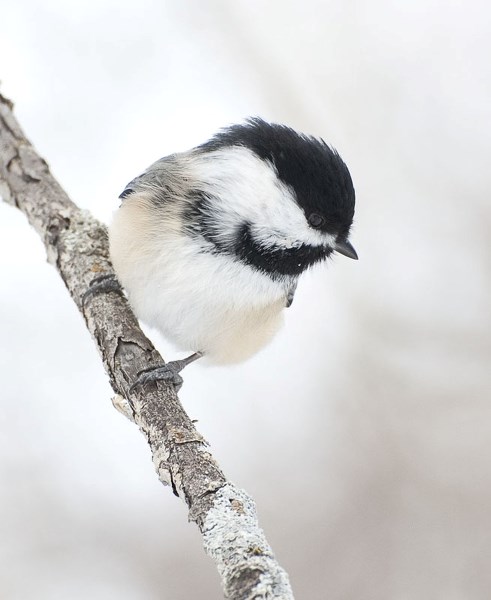A chickadee saved my life. It was years ago, during winter. I was horribly depressed, again, and my family suggested I go for a walk to clear my head.
A chickadee saved my life.
It was years ago, during winter. I was horribly depressed, again, and my family suggested I go for a walk to clear my head. Skeptical, I tromped out into the snow in my ugly purple coat to the nearby ravine, stewing in my thoughts.
That's when I heard it: "Chicka-dee-dee-dee. Chicka-dee."
Curious, I traced the sound to a tiny white and grey ball of feathers with a black cap and bib. It flickered from branch to branch, chattering away, cocking its head to look at me askance with its beady little eyes. I stood there, entranced by this little ball of life – a reminder that there was something more to life than me and my petty troubles.
It fluttered deeper into the woods. I left my worries behind and followed.
The black-capped chickadee is one of the most common birds in St. Albert. It's also a creature that sparked my love of nature and changed the course of my life.
These birds hang around St. Albert year-round and can be recognized for their distinct "chicka-dee" call, black hat and black beard, says veteran birder Peter Demulder.
"They're very cheerful," he said, and will even eat from your hand if you're patient.
"Chickadees are, to me, the bird of Alberta," he said.
You might mix up a black-capped with a boreal chickadee, which has a brown cap instead of a black one, Demulder says.
"It's described as a chickadee with a bad cold," as it sounds like it has a stuffed-up nose, he says. These birds favour deep woods and are rare in the city.
In the wild chickadees feed almost exclusively on bugs but will gobble sunflower seeds in the city, says Colleen Cassady St. Clair, a biologist at the University of Alberta.
Chickadees only carry enough fat to survive a single winter night, she continues, so they have to eat every day. They'll cache hundreds of seeds a day in tiny hordes to prepare for winter.
"If you check carefully in the small cracks on the side of your house or fence, you'll sometimes find seeds cached there," she says.
Chickadees can drop their body temperatures at night to save energy, St. Clair says, and fluff up their feathers by 1.5 centimetres for better insulation. They'll also choose different campsites based on temperature: spruce boughs if it's warm, tree cavities if it's cold, and holes under the snow if it's freezing.
Black-caps tend to bunk together in groups of eight to 10, which can get a bit cramped, Demulder notes. Pay attention, and you might see a chickadee with "bed-head" feathers in the morning as a result.
One of the most fascinating aspects of the black-capped chickadee is its call.
A chickadee's call has four distinct notes – dubbed A, B, C, and D – that always happen in that order, says St. Albert psychologist and University of Alberta researcher Chris Sturdy. The C notes are thought to convey information on food, while the Ds are used for threat assessment – the more "dees" and the faster they come, the greater the threat.
"One of the calls you're going to hear all the time from the chickadee is the 'seet,'" he says, which is a short, single note that looks like an inverted V on a spectrogram. Subtle changes in the frequency and duration of these calls let the birds communicate their species, gender and location with a single note.
"We were actually pretty blown away" by its complexity, he says.
The other one, used during mating season, is the "fee-bee" call, which Demulder says sounds like "hey sweetie!"
"The first note is always 1.13 times higher than the second note," Sturdy notes, and only the healthiest males can maintain such a consistent pitch. Females likely use this pitch shift to judge the fitness of their mates.
Black-caps can be very pugnacious, Demulder says, and will even buzz predators to deter them.
They can also be very territorial in the spring, Sturdy says, with mated pairs vigorously defending their turf. When he set up a fake chickadee in another bird's yard as an experiment, the real bird was so mad that it pecked off the fake bird's head. In the winter, however, the birds will form large groups and live together peacefully.
Last year, when I dropped a coin into a donation box at a nature sanctuary, a chickadee immediately flew up to me and chattered away, as if to say, "Thank you."
Thank you, chickadee, for changing my life.
Black-capped chickadee
Name:<br />Poecile atricapilla.<br />
Appearance:<br />Small spherical bird with black cap, black beard, grey wings, white cheeks, beady eyes. <br />
Commonly seen:<br />Bouncing between branches of a tree, eating seeds from a feeder one at a time. <br />
Occasionally confused with:<br />Boreal chickadee, which has a brown cap.<br />
Fun fact:<br />They can remember where they've hidden food for at least 28 days.
Wild St. Albert
Like wildlife? So do we! Every second Wednesday the Gazette profiles a reasonably common wild creature in the St. Albert region. Birds, beasts, bugs, fish … so long as it's alive and kicking, we'll feature it. <br /><br />Got a creature you'd like to see profiled? Send your suggestions to [email protected].




